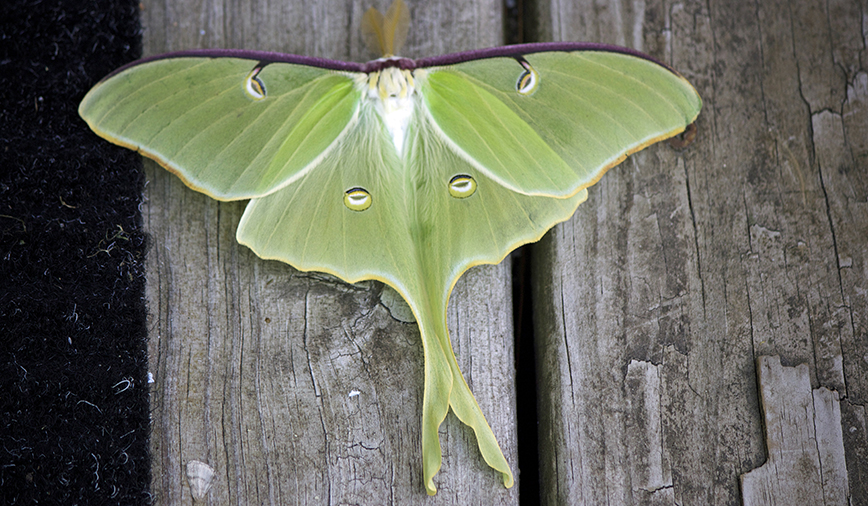Pam’s Perspective
From the…
Pam Otto is the Manager of Natural Programs and Interpretive Services for the St. Charles Park District
May 18, 2012
With all the dire warnings emanating from Chicago regarding the NATO Summit, the Windy City is the last place I’d want to find myself this weekend. The media have been telling us for weeks to expect traffic and transit disruptions, protesters and heavy security at every turn.
I thought I’d be safe here, in the relative sanctuary St. Charles provides. But then I received this message, from our ever-vigilant park safety officer Tim Timberlake: Giant Killer Moth.
Well, shoot.
Tim was at Otter Cove, our aquatic park, when he made the chilling discovery. As I read his words, I flirted briefly with the idea of heading to Chicago for the week. No Killer Moth would dare go there, at least for the next few days.
My mind then flashed back to the last time I’d gotten word of a Giant Killer Insect. That particular critter turned out to be a dobsonfly, a large, primitive-looking creature that in its larval stage is known as a hellgrammite (as well as a toe-biter, but we won’t get into that right now). The woman who’d found the dobsonfly was fairly convinced it was a mutant insect created by, she thought, subversive activities at Fermilab that were generating, she supposed, radioactive waste.
Adobe Systems
When we told her it was a native insect, and a sign of good, clean water, I think she was relieved, but also a little disappointed. A bug that belongs here and is a sign of a healthy ecosystem is a good thing, but doesn’t make near as good a story as a Giant Killer Insect.
Which brings us to this most recent incident.
Now first let me say, Tim is no stranger to local beasties. Over the course of his years with the park district he’s wrangled raccoons, chased after stray dogs and even had a face-off with a mama sandhill crane who felt his truck seemed a threat to her wandering brood. He’s also experienced with invertebrates, most notably when he armed himself with cardboard and coerced our tarantula back into her cage the day she went rogue.
But his Spidey senses had never tingled the way they did the other night, when he saw a creature unlike any he’d dealt with before.
“It was literally the biggest moth I’ve ever seen,” he said.
Lucky for us, Tim’s used to encountering strange things during his late-night rounds. Where others might have balked in the face of such perceived danger, Tim forged ahead, bravely reaching for his phone and boldly snapping a picture of the Giant Killer Moth.
Also known as Actias luna, the luna moth, this secretive creature is one of the lesser known denizens of our nocturnal landscape. Giant, yes. With a wingspan of around four inches, the luna moth is one of our largest native moths. But Killer? Well, not so much.
Like other members of Saturniidae, a family of moths that includes some of the largest insects on the planet, luna moths have no functional mouthparts. They do all their feeding as youngsters, living as plump, thumb-sized green caterpillars on our native hardwood trees. (Fittingly enough for us here at Hickory Knolls, the hickory tree is a favorite species for luna moths. But not to worry. Unlike the gypsy moth, a species that produces huge numbers of offspring that can defoliate entire trees, the luna moth young’uns are present in small numbers and don’t pose a threat to our woodlands.)
After feeding for several weeks on nourishing leaves, luna caterpillars use more leaves, and silk, to spin their cocoons. After a few weeks, or months if they’re overwintering, the adult moths emerge, let their wings expand, and fly off to complete the last two items on their to-do lists: mate, and die.
Yep, despite their magnificent size and regal appearance, adult luna moths aren’t long for this world. A few days, maybe a week, is what they can expect at this stage of the game.
Needless to say, time is of the essence. Over the next few weeks these gentle giants will be using their killer good looks (and an impressive array of pheromones, or chemical attractants) to get down to the business of creating the next generation of luna moths. Look for them in and around rich woods. They can be hard to spot at night, among the leaves, but they frequently can be found during the day resting on tree trunks, as well as the sides of houses and other buildings.
The eyes of the world will be trained on Chicago this weekend. But I know where mine will be—out looking for giant killer, I mean luna, moths.

